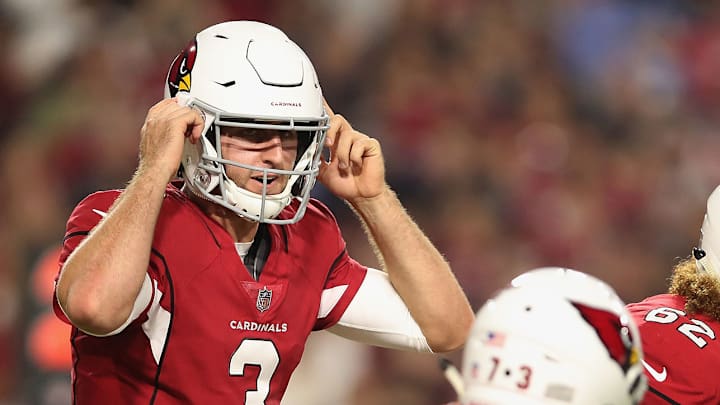10 Thoughts on the 2018 Cardinals, Who Are Talented But Face a Transition Year

With the NFL season just a few weeks away, Andy Benoit is previewing every NFL team in reverse order of last season’s finish. Up today: the Arizona Cardinals, who finished 8–8 in 2017.
1. Just one NFC defense blitzed more than Arizona's last year: Carolina’s … which was led by new Cardinals head coach Steve Wilks. It was Wilks’s only season as a coordinator; prior to that, he spent 11 years as a defensive backs coach for the Panthers, Chargers and Bears. He puts unique pressure on his defensive backs, as many of his blitzes involve single-high zone coverage, not man-to-man. By converting a pass defender into a pass rusher, you become one body short in coverage, enlarging the voids in your zones. Wilks was comfortable with this in Carolina because he had outstanding linebackers in Luke Kuechly and Thomas Davis. His Arizona linebackers, recent first-round picks Deone Bucannon and Haason Reddick, have comparable speed to those Panthers, but not yet nearly as much on-field awareness.
What Wilks didn’t have in Carolina was a shutdown corner, which he now has in Patrick Peterson. Don’t be surprised if many of his Arizona zones deploy Peterson in iso-man coverage outside. Wilks also didn’t have a dynamic slot defender. Second-year safety Budda Baker might not be a true slot corner, but considering that’s where many of Wilks’s blitzes derive, Baker's athletic burst could ultimately make him a cornerstone there.
2. What might keep Baker out of the slot is Arizona’s lack of depth at safety. The options behind him consist of last year’s sixth-rounder Rudy Ford, undrafted rookies or, perhaps, yet-to-be converted corners. Depth is not a concern only at safety. Arizona has a strong starting defense but the NFL’s weakest bench.
Another Frustrating Day for Rosen
3. No defender has created more negative plays for offenses over the last two years than Chandler Jones. He has the right side defensive end spot locked down. At left defensive end are two intriguing talents. First is Markus Golden, coming off an October ACL injury. Second is Reddick, who spent most of training camp at linebacker but should inevitably get a crack at rushing the passer, which was his forte in college. If either fully emerges, Arizona’s edge rushing will be outstanding. If both emerge, it could be unstoppable.
4. If third-year pro Robert Nkemdiche doesn’t hone some of his extensive raw talent in 2018, he never will. Nkemdiche’s athletic frame and initial quickness are a purer stylistic fit in Wilks’s 4-3 than they were in departed defensive coordinator James Bettcher’s hybrid 3-4.
5. Keep an eye on Olsen Pierre. The undrafted fourth-year defensive lineman jumps out on film. He’s proficient on the stunts and twists that Wilks features and has the tenacity to consistently make plays late in the down.
6. Sam Bradford has orchestrated a variety of offenses. During his brief stint as Minnesota’s starter last season he flourished on the type of quicker underneath throws that define much of Cardinals offensive coordinator Mike McCoy’s system. That said … the Cardinals, though talented enough to harbor a win-now mentality, are likely in a rebuilding season. And, notably, Josh Rosen was the most pro-ready quarterback in this year’s draft. At UCLA he worked many of the route combinations McCoy will feature. Expect Rosen to take over before season’s end.
How Will New Offensive Coordinator Mike McCoy Shape the Cardinals' Offense?
7. Larry Fitzgerald is the only known entity of this young receiving corps. At nearly 35, he’s as productive as ever, but through different means than early in his career. He’s no longer swift enough to consistently win on the perimeter, but his patience and route running mechanics have translated remarkably well to the slot. It’s a great reminder that speed can be overrated; as a receiver, defenders have to react to YOUR tempo. Super savvy technique can be enough to create separation.
8. He’d never say this, but last year’s broken wrist was a financial blessing in disguise for David Johnson. He saved a year on his legs and got closer to the end of a rookie contract that pays just under $2 million this season, making him the best bargain in pro football (if not pro sports). Johnson’s combination of lateral strength and agility is unparalleled. A play called “just give David the ball” would constitute smart, not lazy, coaching.
9. It’ll be interesting to see how much fullback Derrick Coleman plays. Johnson’s running style might not be conducive to a lead-blocker.
10. Yes, it’s a retooled offensive line, but not necessarily a better one. Left tackle D.J. Humphries is gifted, but injuries have cost him 14 games in two years. Left guard Mike Iupati is too prone to mental mistakes and physical breakdowns. Center A.Q. Shipley is out with a torn ACL, so the Cards are counting on third-round rookie Mason Cole. At right guard, Justin Pugh’s $15.75 million guaranteed free agent contract makes it easy to forget that he was wildly up and down for the Giants last year. And thanks to a weird mix of injuries, great plays and execution gaffes, 10th-year right tackle Andre Smith remains unofficially the NFL’s biggest enigma.
BOTTOM LINE: Once injuries start hitting, this team will crumble. Expect a trying transition year in Arizona.
• Question or comment? Email us at talkback@themmqb.com.
